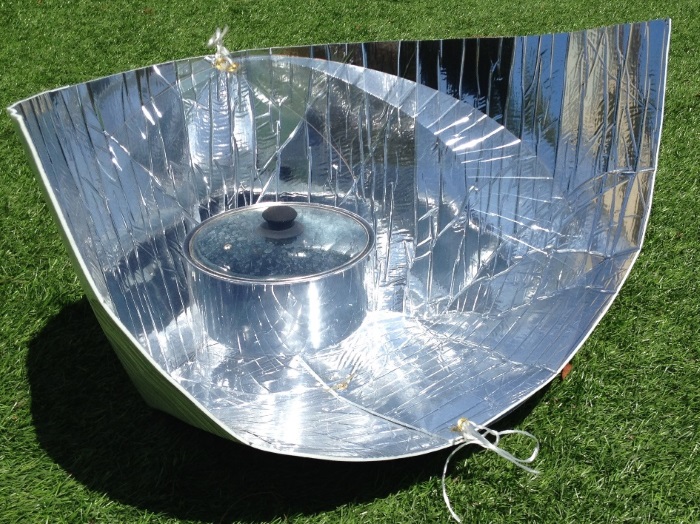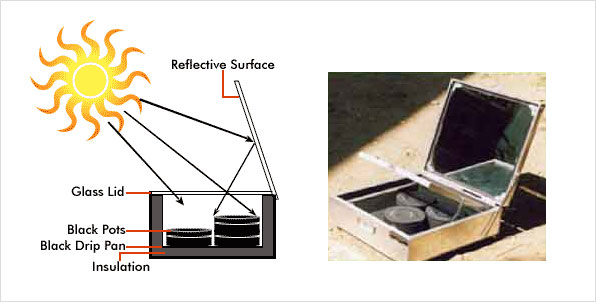A solar box cooker harnesses the sun’s energy to heat food. It uses reflective surfaces to concentrate sunlight into an insulated box.
Utilizing the abundant power of the sun, a solar box cooker provides an eco-friendly alternative to traditional cooking methods. By concentrating solar radiation into a contained area, it effectively converts light into heat, allowing meals to be prepared without the need for fuel or electricity.
This type of cooker typically features a simple design, with reflective panels directing sunlight into a well-insulated interior where cookware is placed. The trapped heat, unable to escape, cooks the food inside over time. This innovative cooking solution is not only cost-effective but also reduces the carbon footprint, making it an excellent choice for sustainable living and outdoor activities. With the ability to sterilize water and cook a variety of dishes, solar box cookers are gaining popularity worldwide as a primary or supplementary cooking resource.
Understanding Solar Box Cookers
Embracing the power of the sun, solar box cookers offer an ingenious way to prepare food while reducing our carbon footprint. This eco-friendly technology harnesses sunlight, transforming it into heat to cook food without the need for conventional fuel. Ideal for sustainability enthusiasts and off-grid adventurers alike, the solar box cooker showcases simplicity and efficiency in design. Let us delve into the intricacies of this remarkable device and how it utilizes the abundant energy provided by our nearest star.
Brief History Of Solar Box Cookers
The concept of using the sun to cook food dates back centuries, but the modern solar box cooker began to take shape in the 20th century. Innovators and environmentally conscious minds have refined and popularized this tech, driven by the need for renewable energy sources and sustainable living practices.
Components Of A Solar Box Cooker
- Insulated Box: The cooker’s core, designed to retain heat.
- Transparent Top: A glass or clear plastic lid that traps sunlight.
- Reflectors: Mirrors or foil-lined panels that direct additional sunlight into the box.
- Cooking Pots: Dark-colored or specially designed pots that absorb maximum sunlight.
The Science Behind Solar Box Cooking
Essentially, a solar box cooker functions as a miniature greenhouse. The transparent top allows sunlight to pass through, getting absorbed by the dark surfaces of the cooking pots and the interior of the box.
Solar energy, in the form of light, converts to heat energy, which the insulated box retains. This elevation in temperature cooks the food over time. The reflectors amplify this effect by increasing the amount of sunlight entering the box. Through this process, the cooker can reach temperatures sufficient to bake, boil, or steam a variety of dishes, all while using a renewable resource.
How Does A Solar Box Cooker Work
The concept of cooking with the sun’s energy is both fascinating and sustainable. A solar box cooker harnesses this abundant natural resource in a simple yet ingenious way. By using the sun’s rays, it offers a method of food preparation that requires no fuel and generates no pollution. Here, we’ll dive into the workings of a solar box cooker and see how it efficiently turns sunlight into a cooking heat source.
Utilizing Solar Radiation For Heating
Solar box cookers embody the basic principles of catching and retaining solar energy. These devices feature reflective surfaces that focus sunlight into a box where the cooking takes place. The interior of the box is often painted black to maximize heat absorption, capturing every bit of solar radiation that enters. Coupled with a transparent lid or glass top, solar box cookers invite sunlight in but then trap the heat, creating a mini greenhouse effect perfect for cooking.
Heat Trapping And Insulation Mechanisms
- Heat retention is crucial in solar box cookers, and it is achieved through well-insulated walls and a sealable lid. The insulating materials prevent the escape of heat, ensuring temperatures rise high enough to cook food.
- Similarly, the transparent lid plays a dual role by letting sunlight in and acting as a barrier for heat loss, much like a closed car on a sunny day.
- The cooker’s design also includes seals or gaskets, which minimize the intrusion of cool air from outside and further protect the cooking environment from heat loss.
Principles Of Heat Transfer Within A Solar Box Cooker
In a solar box cooker, heating is not just about trapping sunlight. The heat transfer within the box follows three principles: conduction, convection, and radiation.
- Conduction: The dark surfaces inside absorb and conduct heat directly to the pot and food within.
- Convection: As air within the cooker warms up, it circulates, transferring heat to every part of the cooking pot.
- Radiation: The trapped heat also radiates within the enclosed space of the cooker, ensuring even cooking.
These principles work synergistically to create a cooking environment where temperatures can soar quite high, mimicking oven conditions, but using purely the power of the sun. The cooker’s design ensures that heat loss is minimal while maximizing the heat input and transfer within the cooker, facilitating the cooking process naturally and efficiently.
Operating A Solar Box Cooker
Solar box cookers harness the pure energy of the sun to cook food, making them a fantastic eco-friendly alternative to traditional cooking methods. Understanding how to operate a solar box cooker effectively is crucial to getting the best culinary results. This section of the blog post dives into the essentials: from setting up your cooker to fine-tuning its placement for optimal energy absorption, and down to the nitty-gritty of solar-powered cooking techniques and practices.
Preparing The Cooker For Use
Getting ready to use your solar box cooker involves a few essential steps to ensure it functions at its peak. Begin by opening the cooker and removing any protective film from the reflective panels if it’s your first time using it. Check that the glass lid that traps heat is clean for maximum sunlight penetration. Place the cooking pots inside – these should be dark-colored to better absorb heat. Preheat the cooker before adding your food by leaving it directed at the sun for about 20 minutes to maximize its temperature.
Optimal Placement And Angling For Maximum Sun Exposure
The positioning of your solar box cooker is a critical factor in optimizing its efficiency. Aim to have your cooker face perpendicular to the sun for the most direct exposure. A good rule of thumb is to align the cooker’s shadow to form a small and concise shape, indicating that the cooker faces directly towards the sun. Adjust the angle based on the season; a steeper angle in winter when the sun is lower and a more horizontal placement during summer months.
Cooking Techniques And Best Practices
- Cookware: Use dark, thin-walled pots for faster heating. Matte finishes absorb heat better than shiny surfaces.
- Food Placement: Cut food into smaller pieces for uniform cooking. Arrange them in a single layer for even exposure to the sun.
- Timings: Solar cooking generally takes longer, so allow for additional cooking time. Start early and use a sun-friendly schedule.
- Temperature Monitoring: Since most solar cookers don’t have temperature gauges, use a thermometer to check if the food is cooked.
- Minimal Liquid: Unlike conventional cooking, use less liquid since water and juices don’t evaporate as quickly in a solar cooker.
Turning the cooker occasionally to follow the sun ensures consistent heating. Slow and steady wins the race — patience is key to perfecting the art of solar box cooking!
Benefits Of Solar Box Cooking
Welcome to the enlightening world of solar box cooking, a revolutionary method that not only harnesses pure sunlight to prepare your meals but also offers a variety of benefits that contribute to a greener planet and a healthier lifestyle. Let’s dive into the multifaceted advantages of this cooking innovation.
Environmental Impact And Sustainability
Solar box cookers are a beacon of eco-friendliness, dramatically reducing one’s carbon footprint by bypassing conventional energy sources. Here’s how they promote sustainable living:
- Zero emissions: They operate without burning any fuel, meaning they don’t produce harmful greenhouse gases.
- Conservation of resources: Solar cookers utilize the abundant and renewable energy of the sun, conserving fossil fuels and biomass.
- Reduced deforestation: In areas reliant on wood for cooking, solar cookers help preserve forests, maintaining biodiversity and vital ecosystems.
Cost-effectiveness And Energy Independence
Embracing the power of the sun with a solar box cooker can have a profound effect on your finances and personal energy security:
| Aspect | Benefit |
|---|---|
| Upfront Investment | Minimal compared to traditional cooking appliances. |
| Running Costs | Virtually non-existent as sunlight is free. |
| Energy Reliance | Encourages independence from grid power and unpredictable fuel markets. |
Health Benefits And Food Quality Improvements
Solar box cookers offer a plethora of health advantages and enhance the culinary quality of dishes:
- Nutrition retention: Gentle cooking processes preserve the natural flavors and nutrients of ingredients.
- Sanitation: The heat generated is sufficient to pasteurize water and sterilize instruments, ensuring food safety.
- Smoke-free: Absence of smoke from burning fuels means cleaner air to breathe, preventing respiratory issues.
In summary, solar box cooking not only enriches your plate but also fortifies your health and safeguards the environment, proving itself as a smart and responsible choice in our increasingly eco-conscious society.
Enhancing Solar Box Cooker Efficiency
Embracing the power of the sun’s rays, a solar box cooker offers an eco-friendly and cost-effective way to prepare meals. Yet, optimizing its functionality is pivotal for peak performance. Enhancing the efficiency of a solar box cooker not only amplifies its cooking prowess but also provides a more sustainable cooking practice. Let’s delve into how we can turbocharge the capacity of these ingenious devices through state-of-the-art materials, design, and user practices.
Material And Design Advancements
The core of heightening a solar box cooker’s efficiency lies in its material composition and structural design. Innovative insulating materials that are light in weight yet exceptional at retaining heat are now replacing older, bulkier substances. These materials minimize thermal loss, keeping the interior of the cooker hotter for prolonged periods.
Reflective surfaces have also seen upgrades. The use of ultra-reflective metallized polyester can effectively direct more solar energy into the cooking chamber. A proper seal on the cooker’s glass top ensures minimal heat escapes, leveraging the greenhouse effect. The design has been tweaked to have adjustable reflectors that can target the sun’s position throughout the day, providing stable and enhanced heating.
Innovations In Solar Box Cooking Technology
Technological strides in solar box cooking are exciting, to say the least. Integration of thermoelectric modules allows for the conversion of excess heat into usable electricity. This power can be employed for multiple purposes, including powering a small fan to circulate hot air and ensure even cooking.
Another breakthrough is the temperature control system. With automated systems that adjust the cooker’s angle relative to the sun, maintaining the optimal temperature for cooking has become more manageable. This not only enhances efficiency but also expands the variety of dishes that can be perfectly cooked using solar power.
Tips For Maximizing Solar Box Cooker Performance
- Preheat the cooker before placing your food inside.
- Use dark, thin-walled pots that absorb solar energy more effectively.
- Seal the cooker well to prevent heat loss.
- Regularly clean the glass top and reflective surfaces for maximum solar gain.
- Place the cooker at an angle where it can get uninterrupted sunlight.
- Cook during the sunniest part of the day — typically from 10 AM to 4 PM.
- Minimize opening the cooker’s lid to prevent heat escape.
Implementing these tips will elevate the performance of any solar box cooker, leading to faster cooking times and broader culinary possibilities.

Credit: www.solarcooker-at-cantinawest.com
Frequently Asked Questions For How Does A Solar Box Cooker Work
What Is The Principle Of Solar Box Cooker?
The principle of a solar box cooker involves trapping sunlight to heat food. Its insulated box captures and retains solar energy, while reflective panels direct more sunlight inside to cook the contents efficiently.
What Are 2 Disadvantages Of A Solar Cooker?
Solar cookers generally have a slower cooking time and depend heavily on sunny weather conditions for efficiency. Their performance drops significantly during cloudy or rainy days.
How Efficient Is Solar Box Cooker?
A solar box cooker is quite efficient, utilizing sunlight to cook food without fuel, often reaching temperatures up to 150°C. It’s eco-friendly, converting solar energy directly to heat with minimal loss.
How Does A Solar Cooker Work For Kids?
A solar cooker uses the sun’s rays, trapped in a box or reflective surface, to heat and cook food without electricity or fire.
Conclusion
Embracing solar box cookers offers eco-friendly culinary adventures under the sun. This innovation harnesses solar power, creating sustainable cooking solutions. As we’ve explored, simple designs yield impressive results, from slow-cooked stews to fresh-baked bread. Adopting this green technology paves the way for energy-efficient dining experiences.
Let’s cook a brighter future together!


what to do when cialis stops working